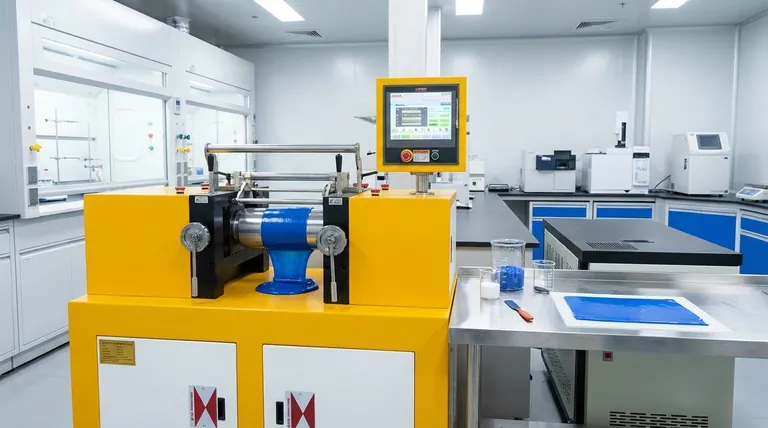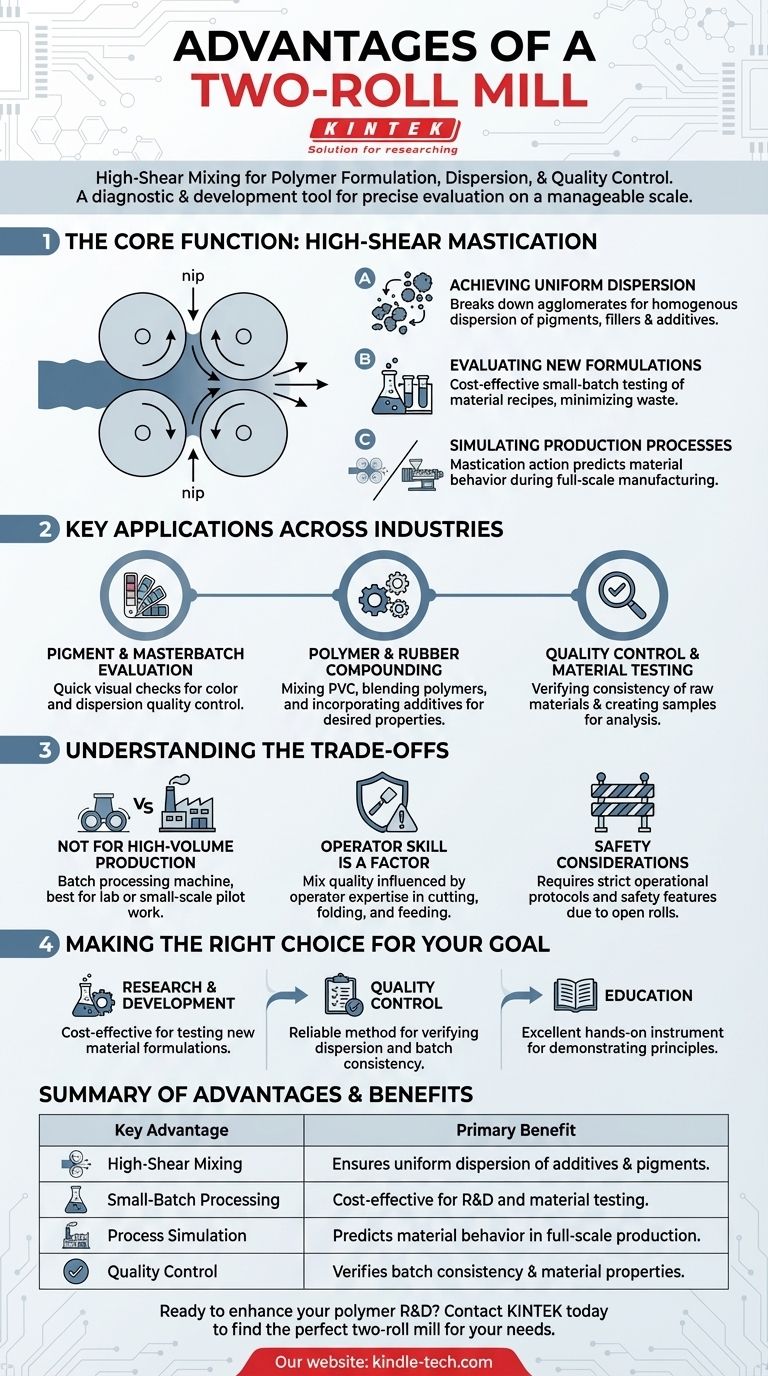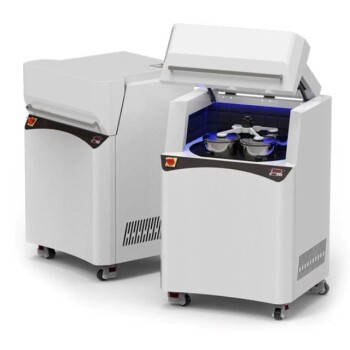The primary advantages of a two-roll mill are its ability to provide high-shear mixing for developing and testing polymer formulations, ensuring uniform dispersion of additives, and serving as a reliable tool for quality control. It excels in small-batch applications common in laboratories for plastics, rubber, and other polymers, making it invaluable for research, development, and process verification.
A two-roll mill is not just a mixer; it is a diagnostic and development tool. Its core value lies in allowing technicians and engineers to precisely evaluate, test, and perfect material formulations on a manageable scale before committing to expensive, large-scale production.

The Core Function: High-Shear Mastication
A two-roll mill works by passing material through the gap, or "nip," between two counter-rotating rolls. This process creates intense mechanical stress and shear, which is fundamental to its advantages.
Achieving Uniform Dispersion
The high-shear forces generated are exceptionally effective at breaking down agglomerates of pigments, fillers, and other additives.
This ensures a homogenous dispersion of these components throughout the polymer matrix, which is critical for consistent color, material properties, and performance.
Evaluating New Formulations
In a laboratory setting, the mill allows for the testing of new material recipes, such as different plasticizers, stabilizers, or masterbatches.
Because it operates with small material quantities, it provides a cost-effective method for material development and experimentation without wasting large amounts of raw material.
Simulating Production Processes
The mill's action of "mastication"—softening and blending a material through heat and mechanical work—simulates the conditions found in larger production machinery like extruders.
This makes it an ideal instrument for predicting how a material will behave during full-scale manufacturing, helping to identify potential issues early in the development cycle.
Key Applications Across Industries
The versatility of the two-roll mill makes it a staple in any setting that involves polymer compounding and evaluation.
Pigment and Masterbatch Evaluation
The mill is a standard tool for color sampling and quality control of masterbatches (concentrated mixtures of pigments or additives).
It allows for a quick and accurate visual check to ensure that the color and dispersion meet the required specifications before use in final products.
Polymer and Rubber Compounding
Its primary application is in the mixing of rubber and plastic compounds. This includes PVC powder mixing, blending different polymers, and incorporating additives to achieve desired physical properties.
The ability to control the roll speed and temperature provides the process control needed for repeatable and reliable test batches.
Quality Control and Material Testing
For quality control, a two-roll mill is used to verify the consistency of incoming raw materials or outgoing product batches.
It serves as a platform to create test samples that can then be analyzed for physical properties, ensuring they conform to established standards.
Understanding the Trade-offs
While highly effective, the two-roll mill is a specialized piece of equipment with specific limitations that must be considered.
Not for High-Volume Production
The two-roll mill is fundamentally a batch processing machine, best suited for laboratory or small-scale pilot work. It is not designed for continuous, high-volume manufacturing.
Operator Skill is a Factor
The quality of the mix can be influenced by the operator's skill in cutting, folding, and feeding the material back into the mill. Achieving perfect consistency can require significant training and experience.
Safety Considerations
The open, rotating rolls present an inherent safety hazard. Modern machines are equipped with extensive safety features, but strict operational protocols are essential to prevent accidents.
Making the Right Choice for Your Goal
To determine if a two-roll mill is the right tool, consider your primary objective.
- If your primary focus is Research & Development: A two-roll mill is an indispensable tool for cost-effectively testing new material formulations and additives.
- If your primary focus is Quality Control: This machine provides a reliable method for verifying the dispersion quality of pigments and the consistency of polymer batches.
- If your primary focus is Education: The mill is an excellent, hands-on instrument for demonstrating the fundamental principles of polymer processing and mastication.
Ultimately, a two-roll mill is the definitive choice for precise, small-scale evaluation and refinement of polymer compounds.
Summary Table:
| Key Advantage | Primary Benefit |
|---|---|
| High-Shear Mixing | Ensures uniform dispersion of additives and pigments. |
| Small-Batch Processing | Cost-effective for R&D and material testing. |
| Process Simulation | Predicts material behavior in full-scale production. |
| Quality Control | Verifies batch consistency and material properties. |
Ready to enhance your polymer R&D and quality control processes? A KINTEK two-roll mill provides the high-shear mixing and precise control your laboratory needs for developing and testing plastics, rubber, and other polymer formulations. Our equipment is designed to help you achieve uniform dispersion, simulate production conditions, and ensure batch consistency—all while saving time and materials on a small scale.
Contact KINTEK today to find the perfect two-roll mill for your laboratory's needs and take the next step in perfecting your material formulations.
Visual Guide

Related Products
- Open Type Two Roll Mixing Mill Machine for Rubber Crusher
- Laboratory Ball Mill Jar Mill with Metal Alloy Grinding Jar and Balls
- Laboratory Single Horizontal Jar Mill
- Laboratory Four-Body Horizontal Jar Mill
- Laboratory Jar Mill with Agate Grinding Jar and Balls
People Also Ask
- What is the disadvantage of a two-roll mill? Limited Thickness Reduction Due to Roll Flattening
- What is the difference between Banbury and internal mixer? Understanding Rotor Design for Better Mixing
- What fillers for rubber compounds? Choose the Right Filler for Performance vs. Cost
- What is meant by two high rolling mill? A Guide to Core Material Processing
- What is a two-high roll mill? Master Precise Material Compounding and Testing



















